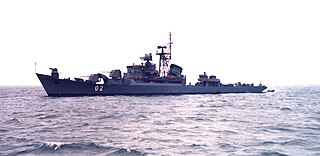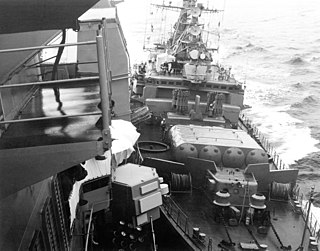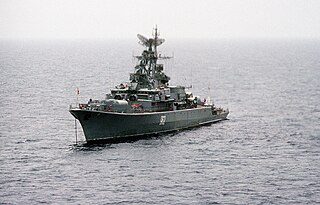
A ship class is a group of ships of a similar design. This is distinct from a ship type, which might reflect a similarity of tonnage or intended use. For example, USS Carl Vinson is a nuclear aircraft carrier of the Nimitz class.

The Kashin class, Soviet designation Project 61, were series of anti-aircraft guided-missile destroyers built for the Soviet Navy since the 1960s. As of 2020, no ships remain in service with the Russian Navy, but three modified ships continue in service with the Indian Navy as Rajput-class destroyers.

The Krivak class, Soviet designation Project 1135 Burevestnik, are a series of frigates and guard ships built in the Soviet Union primarily for the Soviet Navy since 1970. Later some sub-branches, like the Nerey (Nereus) were designed for coastal patrol by the KGB Border Troops. Until 1977, the ships in the class were considered to be large anti-submarine warfare vessels.

The Bulgarian Navy is the navy of the Republic of Bulgaria and forms part of the Bulgarian Armed Forces. It has been largely overlooked in the reforms that Bulgaria had to go through in order to comply with NATO standards, mostly because of the great expense involved and the fact that naval assaults are not considered to be a great concern for the country's security. That is why three of the four Romeo-class submarines are now docked and have been out of operation for some time. The last one was decommissioned in November 2011. Only the more modern frigates, corvettes and missile crafts are on active duty.

The RBU-6000Smerch-2 is a 213 mm caliber Soviet anti-submarine rocket launcher. It is similar in principle to the Royal Navy Hedgehog system used during the Second World War. The system entered service in 1960–1961 and is fitted to a wide range of Russian surface vessels. It consists of a horseshoe-shaped arrangement of twelve launch barrels, that are remotely directed by the Burya fire control system. It fires RGB-60 unguided depth charges. The rockets are normally fired in salvos of 1, 2, 4, 8 or 12 rounds. Reloading is automatic, with individual rounds being fed into the launcher by the 60UP loading system from a below deck magazine. Typical magazine capacity is either 72 or 96 rounds per launcher. It can also be used for shore bombardment.

The Koni class is the NATO reporting name for an anti-submarine warfare frigate built by the Soviet Union. They were known in the Soviet Union as Project 1159. 14 were built in Zelenodolsk shipyard between 1975 and 1988. They were originally intended to replace the older Riga-class frigates, but were instead chosen as a design for export to various friendly navies. The Koni I sub class were designed for European waters and the Koni II were made for warmer waters. One ship was retained by the Soviets in the Black Sea for training foreign crews. Only a few of these vessels remain in service today.

The Riga class was the NATO reporting name for class of frigates built for the Soviet Navy in the 1950s. The Soviet designation for these ships was Storozhevoi KorablProject 50 Gornostay. The Riga class was analogous to World War II era destroyer escorts.

The Petya class was the NATO reporting name for a class of light frigates designed in the 1950s and built for the Soviet Navy in the 1960s. The Soviet designation was "Storozhevoi Korabl`" Project 159.

The Kola class was the NATO reporting name for a group of frigates built for the Soviet Navy in the 1950s. The Soviet designation was Storozhevoi Korabl Project 42. These ships were analogous to World War II era destroyer escorts or German Elbing-class torpedo boats. The programme consisted of only 8 ships as these vessels were considered to be too expensive for series production and the smaller and cheaper Riga-class frigate was built instead. Radars and sonars were fitted.

The Black Sea bumping incident of 12 February 1988 occurred when American cruiser USS Yorktown tried to exercise the right of innocent passage through Soviet territorial waters in the Black Sea during the Cold War. The cruiser was bumped by the Soviet frigate Bezzavetny with the intention of pushing Yorktown into international waters. This incident also involved the destroyer USS Caron, sailing in company with USS Yorktown and claiming the right of innocent passage, which was intentionally shouldered by a Soviet Mirka-class frigate SKR-6. Yorktown reported minor damage to its hull, with no holing or risk of flooding. Caron was undamaged.

Razumnyy was a 1135 Burevestnik-class Large Anti-Submarine Ship or 'Krivak' class frigate that served with the Soviet and Russian Navies. Launched on 20 July 1973, the vessel operated as part of the Pacific Fleet, as a dedicated anti-submarine vessel, with an armament built around the Metel Anti-Ship Complex. The vessel undertook a number of tours, visiting the People's Democratic Republic of Yemen and India. The ship was decommissioned on 16 March 1998 and subsequently disarmed ready to be broken up before the end of the year.

Zadornyy was a Project 1135 Burevestnik-class guard ship or Krivak-class frigate that served with the Soviet and Russian Navies. Displacing 3,200 tonnes full load, the vessel was built around the Metel anti-submarine missile system. Zadornyy was launched on 25 March 1979 in Leningrad, the last of the class to be built by the A.A. Zhdanov shipyard, and served with the Northern Fleet. After taking part in exercises Avangard-81, Sever-81 and Okean-83, and cruising as far as Havana, Cuba, the vessel was upgraded between 11 June 1990 and 23 May 1995 with missiles that added anti-ship capability. While serving with the Russian Navy, the ship took part in joint exercises with frigates of the Royal Navy, including a commemoration of the first Arctic convoy of the Second World War with HMS Campbeltown. After more than twenty-five years service, the ship was decommissioned on 3 December 2005.

Deyatelnyy was a Soviet Navy 1135 Burevestnik-class Large Anti-Submarine Ship or Krivak-class frigate. Displacing 3,200 tonnes full load, the vessel was built around the Metel anti-submarine missile system. Launched on 6 April 1975, Deyatelnyy served with the Black Sea Fleet and, as well as Bulgaria in the Black Sea, spent the next two decades travelling as far as the Mediterranean Sea to visit ports in North Africa for cultural reasons and to improve relations between the Soviet Union and other nations, For example, in 1981, the ship was the first Soviet vessel for more than ten years to visit Libya. In 1987, the vessel was used to test a new missile for the Metel system that added anti-ship capability. The ship was taken out of service for repair and modernisation in 1991. However, lack of funding meant that, instead, Deyatelnyy was decommissioned on 10 June 1995 and broken up.

Boris Borisovich Kozhin or Borys Borysovych Kozhyn ; born 25 October 1944) is a Ukrainian retired vice admiral and politician who served as the first commander of the Ukrainian Navy from April 1992 to October 1993. He later served as a People's Deputy of Ukraine on the party list of the People's Movement of Ukraine from 1998 to 2002.

Doblestnyy was a Project 1135 Burevestnik-class Large Anti-Submarine Ship or Krivak-class frigate. With an armament centred on four Metel missiles, the ship was launched on 22 February 1973 and joined the Northern Fleet of the Soviet Navy as a dedicated anti-submarine vessel. Doblestnyy was designated a Guard Ship from 28 July 1977 in response to a change in emphasis of the navy, and subsequently undertook visits to a number of African nations, including Angola and Ghana. Taken out of service to be repaired and upgraded on 19 June 1991, a lack of funding meant that this was cancelled and instead the vessel was decommissioned. The vessel was sold to be broken up on 18 July 1995.

Svirepyy was a Project 1135 Burevestnik-class Large Anti-Submarine Ship or Krivak-class frigate that served with the Soviet Navy. Displacing 3,200 tonnes full load, the vessel was built around the Metel anti-submarine missile system. The ship was launched on 27 January 1971 in Kaliningrad and joined the Baltic Fleet. The ship's service was not restricted to the Baltic Sea and instead travelled widely, visiting a number of foreign friendly ports during the next two decades, including Gdynia, Poland and Havana, Cuba. Svirepyy was designated a Guard Ship from 1977 as Soviet strategy changed to one creating safe areas for friendly submarines close to the coast. However, the ship continued to travel widely, including trips to the capital cities of both Finland and Tunisia as well as Rostock in East Germany. Svirepyy was transferred to the Russian Navy after the dissolution of the Soviet Union, but did not last long before being decommissioned on 30 June 1993 and subsequently broken up.

Razyashchiy was a Project 1135 Burevestnik-class Large Anti-Submarine Ship or Krivak-class frigate of the Soviet Navy. Displacing 3,200 tonnes full load, the vessel was built around the Metel anti-submarine missile system. Launched on 22 July 1974, Razyashchiy joined the Pacific Fleet of the Soviet Navy. While serving in the Arabian Sea, in 1983, Razyashchiy suffered minor hull damage from colliding with the destroyer USS Fife while approaching a US fleet. The ship also undertook visits to Port Louis, Mauritius, and Danang, Vietnam, to, among other objectives, enhance the relationships between these countries and the Soviet Union. In 1991, the vessel was transferred to the newly-formed Russian Navy. After nearly twenty years of service, however, Razyashchiy was in a poor state and so was decommissioned on 29 October 1992 and sold to be broken up on 6 October 1994.

Gromkiy was a Project 1135M Burevestnik-class Guard Ship or 'Krivak II'-class frigate that served with the Soviet and Russian Navies. Launched on 11 April 1978, the vessel operated as part of the Northern Fleet as an anti-submarine vessel, with an armament built around the URPK-5 Rastrub missile system. In 1991, the ship took part in the semicentennial commemoration of the first of the arctic convoys of the Second World War alongside the Royal Navy frigate HMS London. Soon afterwards, the ship was transferred to the Russian Navy following the dissolution of the Soviet Union. Gromkiy served for less than two years in this new role before being withdrawn for repairs and, ultimately, decommissioning on 16 March 1998.

Bessmennyy was a Project 1135M Burevestnik-class Guard Ship or 'Krivak II'-class frigate that served with the Soviet and Russian Navies. The vessel was the seventh of the class to enter service. Launched on 17 September 1977, Bessmennyy was designed to operate as an anti-submarine vessel with the Northern Fleet, using an armament built around the Metel Anti-Ship Complex. Following the dissolution of the Soviet Union, in 1991, the ship was transferred to the Russian Navy and took part in a pioneering visit to Gibraltar two years later, the first time that Russian warships had visited the territory in living memory. Bessmennyy was retired on 16 March 1998, disarmed and subsequently broken up.





















